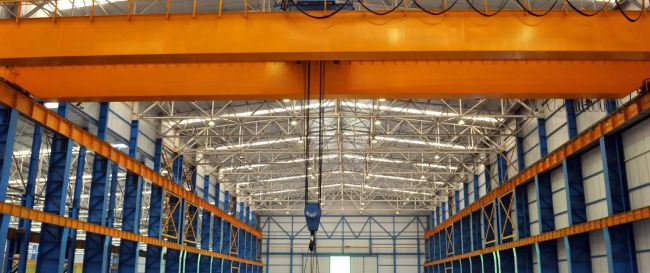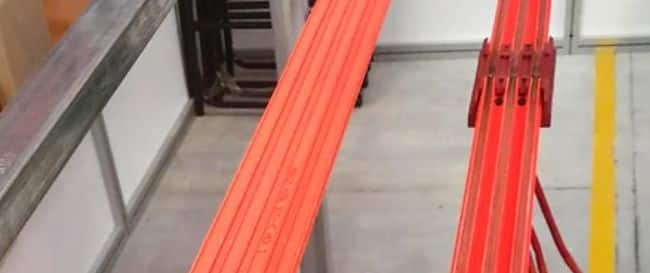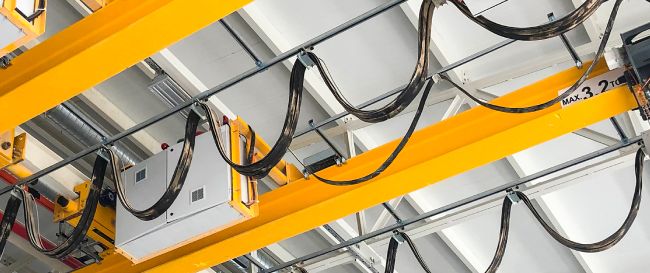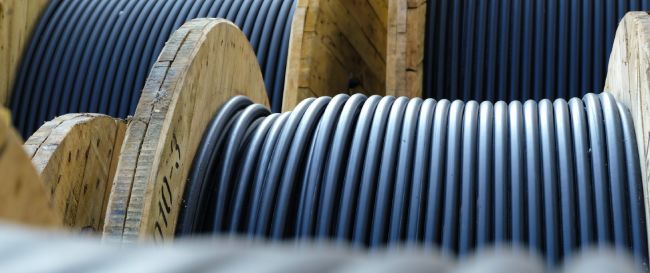Crane and Hoist Electrification

Cranes used for material handling or dockside cranes need to be electrified and powered in order to be able to undertake work. Crane electrification methods are chosen and also have to be reliable, as a day that the crane is unable to operate could be quite costly. The two main methods of crane and hoist electrification are cable reels and overhead lines.
Got a question?
Talk to the experts today, get the support that speaks your language...
What are the different methods of achieving crane electrification?
1. Conductor Bar System/ Static Busbar
This is a simple means of achieving crane and hoist electrification, whereby conductive cables are used to connect the power supply to the crane’s trolley. The conductor bar system consists of an overhead track along which the cable can travel in order to provide power to the hoist when it is in motion. It is usually chosen for applications where there is limited floor space or access. Conductor Bar System/ Static Busbar are by far the best choice: no cables, no snagging, easier to fix if something goes wrong and extremely efficient.

2. Festoon Cabling
Festoon cabling is a system whereby several cables are mounted onto a track allowing them to travel as the hoist moves. The cables run from the power supply and connect to a trolley on the crane, providing it with power during operation. This method is suitable for most applications where there is plenty of floor space or access. If something comes loose or is snagged, then the whole festoon needs to be investigated for breakage, and then the entire system needs to be replaced.

3. Cable Reels
Cable reels are another option when it comes to crane electrification, and they provide an efficient way of powering cranes that require generous accelerations and decelerations, such as those found in dockside or harbour applications. Cable reels consist of several drums connected together, which allow the cable to move with the hoist. The cable reels are connected directly to the power supply, and then the cables themselves are connected to a trolley on the crane. Cable Reels, also known as electrical cords or power reels, are one of several alternatives for providing power to electric hoists. Multiple conductor power cable is wrapped around a drum, which rotates to payout or retracts the necessary length of cable for the application. These are suitable for applications where there is plenty of floor space or access and offer a great solution for moving loads.

MCRS are a Manufacturer of Static Busbar Components
MCRS manufacture Static Busbar components, which are a great solution for crane and hoist electrification. The system consists of an overhead track along which the cable can travel in order to provide power to the hoist when it is in motion. It is usually chosen for applications where there is limited floor space or access and offers a highly efficient way of powering cranes that require generous accelerations and decelerations, such as those found in dockside or harbour applications. The cables are connected directly to the power supply, and then the cables themselves are connected to a trolley on the crane.
There are a few different methods of achieving crane electrification. Each method has its own advantages and disadvantages, so it is important to take into account the application in order to determine the most suitable solution. The conductor bar system/static busbar, festoon cabling, and cable reels are all viable options for providing power to electric hoists, but ultimately the choice should be based on what is most applicable for the specific purpose. MCRS manufacture Static Busbar components, which offer an efficient and reliable way of powering cranes that need generous accelerations and decelerations along with limited floor space or access.
Get In Touch to Enquire About Static Busbar Systems
You can contact our friendly, knowledgeable and experienced team for enquiries relating to the production of Conductor Bar components and any cold roll forming enquiries via telephone, email or filling out the contact form
For more information....
